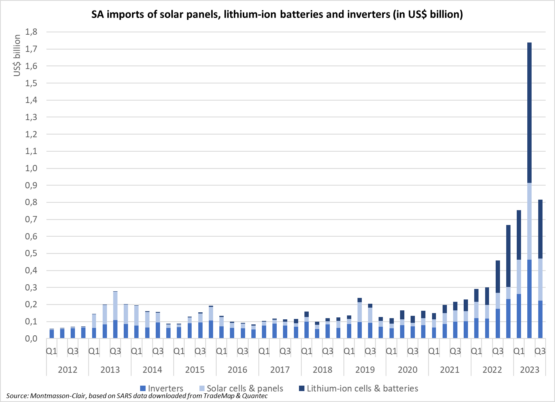The amount of installed rooftop photovoltaic solar on commercial and residential buildings doubled in the past year, according to data from Eskom. At the end of November 2023, total capacity was 5.04GWp (gigawatt peak), up 108% from the 2.4GWp level a year prior. This dramatic increase shows just how quickly businesses and households (with the means) are abandoning the grid as load shedding hit a record level in 2023.
Last year, load shedding was more than double the amount experienced in 2022 at 24.6GWh (versus 11.8GWh) according to the Load Shedding Notifier app. ESP.info says there were 6 907 hours of load shedding last year compared to 3 776 hours in 2022.
ADVERTISEMENT
CONTINUE READING BELOW
Read:
Load shedding in 2023 worse than the last eight years combined
Load shedding to remain at high levels over next five years – Eskom
While Gauteng has the largest installed base of solar photovoltaic (PV), at 1 217MWp, the increase in the past year has been the lowest – just 43% – among all nine provinces. The Western Cape saw the biggest increase, with installed capacity practically tripling in the year. There was also a large jump in the North West (over 200%), likely due to a few sizeable plants supplying mines in the province coming onstream.
| Solar PV (MWp) | |||
| Nov 2022 | Nov 2023 | Change | |
| Eastern Cape | 130.2 | 368.2 | 183% |
| Free State | 160.3 | 280.2 | 75% |
| Gauteng | 848.3 | 1,216.6 | 43% |
| KwaZulu-Natal | 368.7 | 810.9 | 120% |
| Limpopo | 189.8 | 413.3 | 118% |
| Mpumalanga | 298.8 | 509.3 | 70% |
| Northern Cape | 79.1 | 129.5 | 64% |
| North West | 184.8 | 669.3 | 262% |
| Western Cape | 161.9 | 642.4 | 297% |
| Total | 2,421.9 | 5,039.6 | 108% |
Source: Eskom
The amount of ‘rooftop’ solar installed by the private sector is nearing triple the 2.2GWp installed to date under the government’s Renewable Energy Independent Power Producer Procurement Programme (Reipppp).
The utility estimates the amount of solar installed by measuring the change in typical energy consumption in certain areas over time and then aggregating this data.
Data from Gaylor Montmasson-Clair, senior economist at Trade & Industrial Policy Strategies, shows that imports of solar panels, lithium-ion batteries and inverters reached $3.3 billion in the first three quarters of 2023. Using a crude average of R18:$1, this is around R60 billion of equipment. The $3.3 billion figure is roughly double the $1.7 billion of imports for the whole of 2022.
Source: Gaylor Montmasson-Clair via X
It is not as simple as equating the 5GWp to five stages of load shedding.
At the midday peak, the 2.2GW of installed Reipppp solar PV produces around 1.8GW for Eskom, with far less produced in the early and late hours of sunlight. In recent years, solar PV has contributed around five million MWh to Eskom.
According to the Council for Scientific and Industrial Research, the average capacity factor of solar PV supply from the country’s various independent power producers’ renewable energy projects was 25% in 2022. This is not directly comparable to rooftop PV but is a useful guide. This means that the 5GW of installed capacity on commercial and residential rooftops equates to 1.25GW at a capacity factor of 25% (even at a more generous capacity factor of 30%, this is 1.5GW).
So, on average, one stage of load shedding during the day.
ADVERTISEMENT
CONTINUE READING BELOW
Flattening the peak
To some extent, rooftop PV is helping to flatten the peak, especially in residential contexts. Many households run on batteries at night, which are charged by the sun during the day. This likely already removes as much as 1GW of demand at night. Load shedding during the evening peak is also mitigated by the contribution of wind Reipppp projects.
Read: Private investors are putting up money to stop load shedding
In recent weeks, this has contributed up to 2 100MW of power to the grid (from an installed base of 3 400MW). Eskom has said that wind producers supply, on average, around 15 000MW.
Without this, load shedding would be one-and-a-half to two stages worse than it is at present during the peak.
Various estimates suggest that solar PV installations will continue to grow substantially this year. This growth will not be driven by households as has been the case in the past few years – many of those with the means to install solar have already done so – but rather by the commercial and industrial sectors.
One estimate puts the pipeline of renewable energy projects at over 13 000MW, which is low when compared to the 2023 South African Renewable Energy Grid Survey, which says that 18GW of projects are at an “advanced” stage of development. Another estimate from a credible analyst says that 3 000MW of this will have materialised by the end of 2024. Most, but not all, of this will be solar.
Read:
Solar infrastructure imports spike, showing up the Reippp
Nersa called to account for municipal electricity distribution failure
Draft IRP 2024 is an ‘admission of failure’

